Paintings .com
Collection
on Google Maps
| Phone Voicemail text 707-875-2911 | Now at the Gallery | email us | ||||||
| Linda Sorensen Paintings .com |
Joshua Meador Collection |
view us on Google Maps |
||||||
| Bodega Bay Heritage Gallery Newsletter, October 2025 | |
 |
|
Historic California Painters |
Thursday - Sunday 11:00 am - 6:00 pm Other times appointment just call or text for an appointment 1580 Eastshore Road (next to Terrapin Creek Cafe) call or text 707-875-2911 View us on Google Maps |
 Linda Sorensen Sunny Bodega Dunes, 24 x 24 |
Bodega Bay Heritage Gallery
|
 California Style Watercolor painter Millford Zornes 1908-2008 Mount San Antonio, 1989 |
 |
|
our August edition 15 Years of Exhibitions at SF's Legion of Honor Museum |
|
our September edition Past Exhibitions at Sacramento's Crocker Museum |
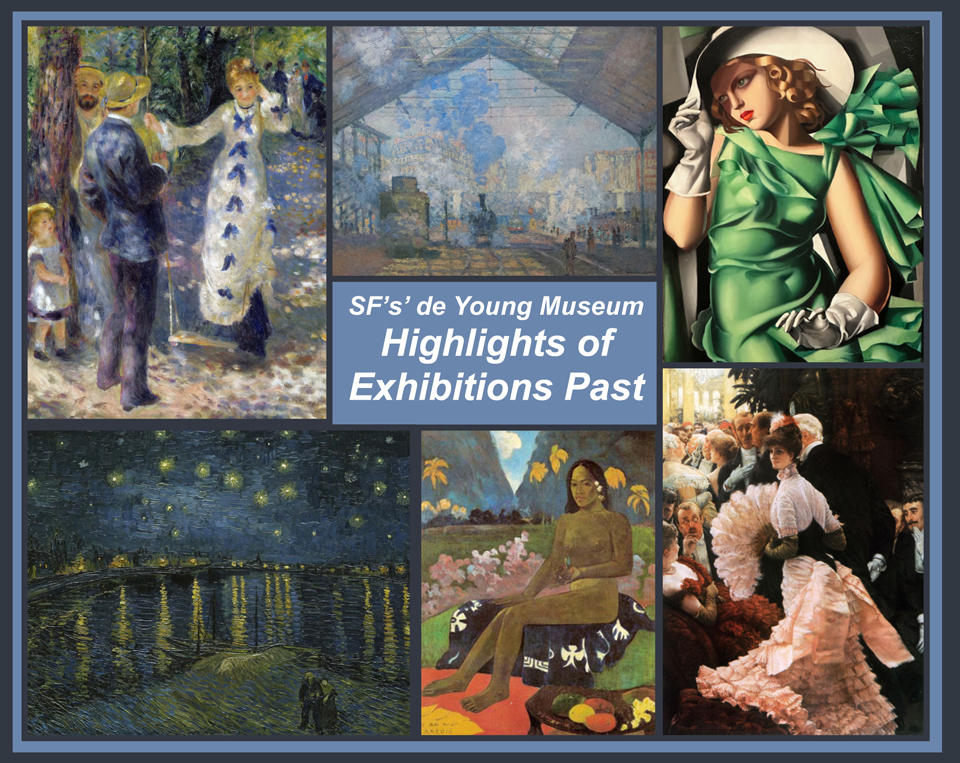 |
Over the past twenty years, the de Young has hosted some truly unforgettable special exhibitions. It’s pretty amazing to think that, for a short time, so many of the world’s greatest paintings were right here at the de Young. Below you’ll find a look back at some of those shows, along with images of the works that left visitors in awe. |
| 15 years of Exhibitions at San Francisco's de Young Museum |
from our Mar '25 edition 15 years ago, The Birth of Impressionism: Masterpieces from the Musée d'Orsay at SF's de Young |
The Birth of Impressionism |
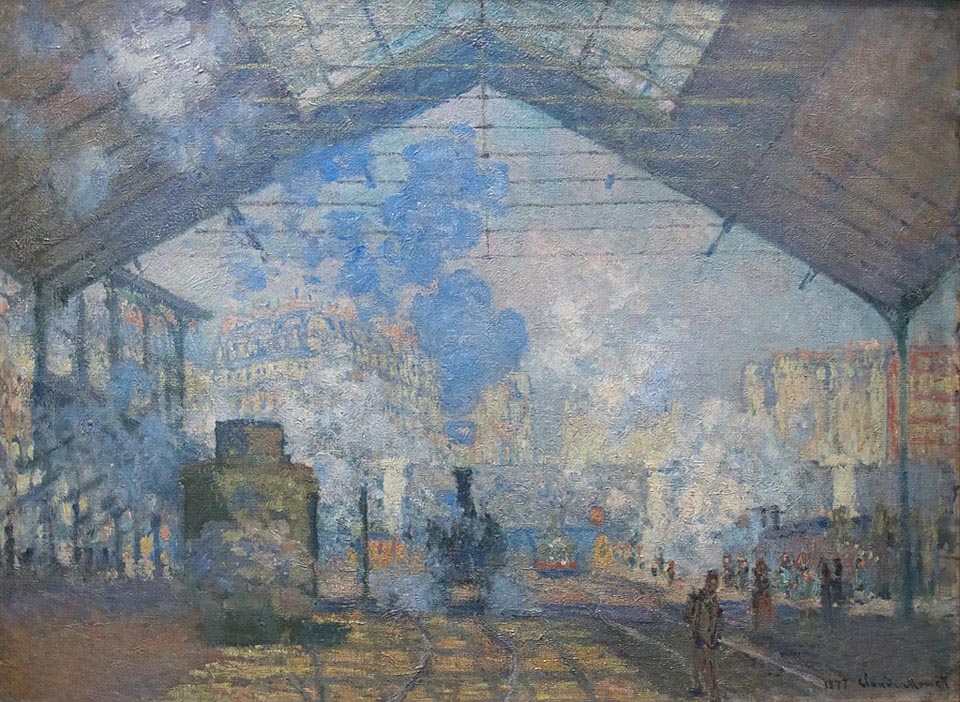 Claude Monet 1840-1926, The Gare Saint-Lazare 1877, Musée d'Orsay, Paris |
|
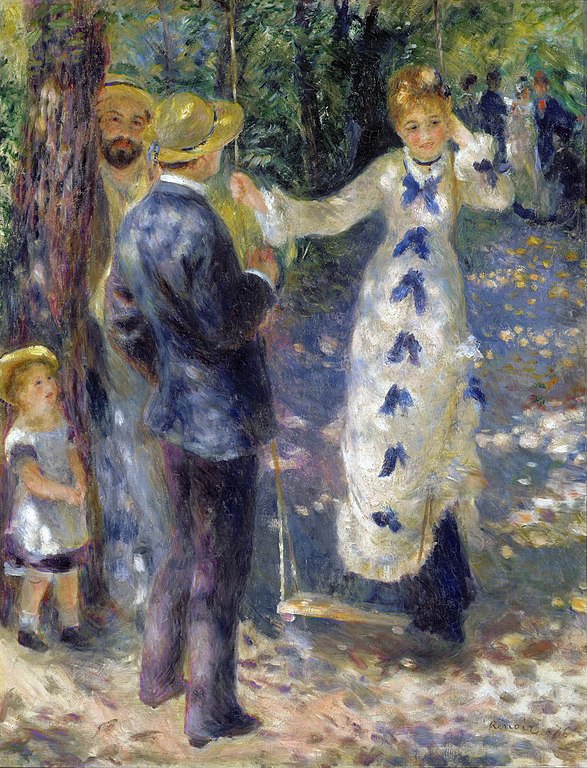 Pierre-Auguste Renoir 1841-1919, The Swing 1876, Musée d'Orsay, Paris |
|
Renoir’s The Swing is a snapshot of a Montmartre garden, showing model on a swing, flanked by two young men and a curious little girl rendered with those flurries of light and color that dissolve solid forms into shimmering atmosphere. The Swing was painted around the same time as Renoir's famous Bal du Moulin de la Galette. Critics were split -- some loved the relaxed charm and dappled sunlight, while others mocked the slashes of color as “grease stains.” It debuted at the Third Impressionist Exhibition in 1877 and was quickly bought by collector Gustave Caillebotte, and later became part of the Musée d’Orsay’s permanent collection. |
|
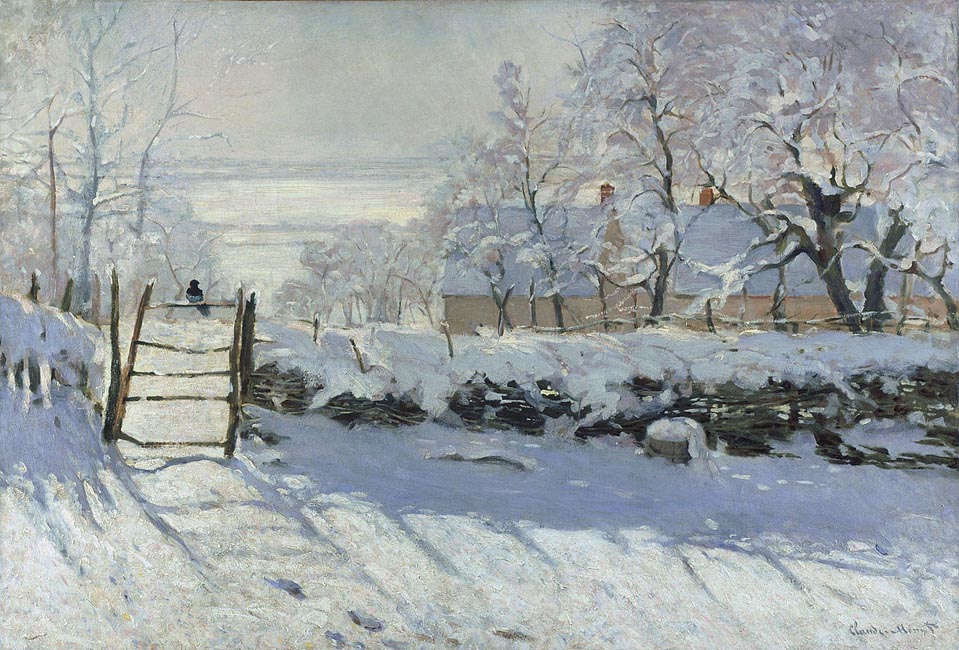 Claude Monet 1840-1926, The Magpie 1868-69, Musée d'Orsay, Paris |
|
|
|
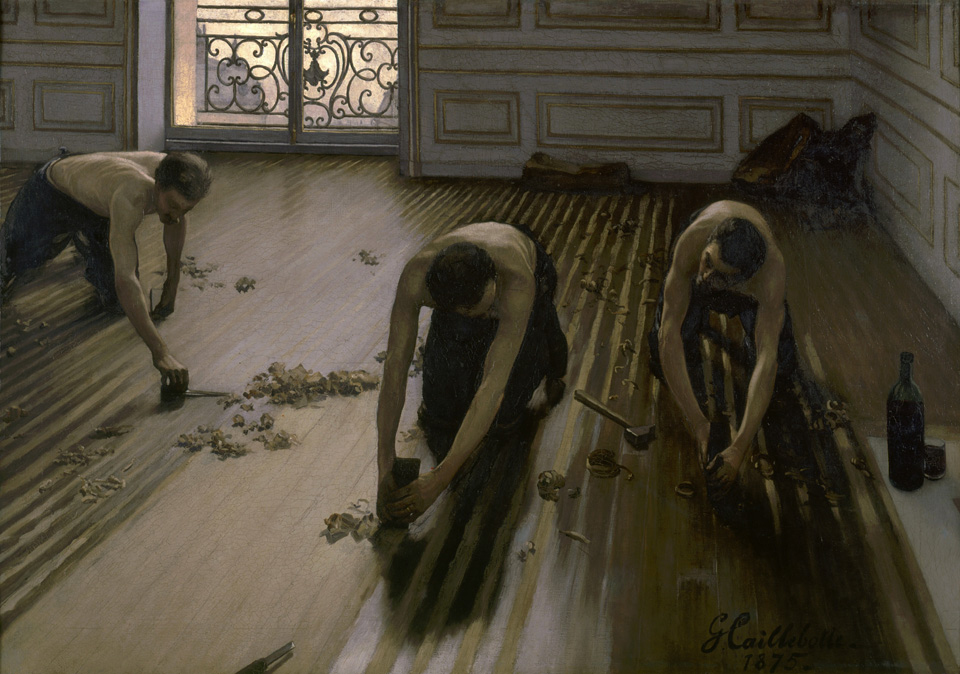 Gustave Caillebotte 1848-1894, The Floor Scrapers (The Planers) 1886, Musée d'Orsay, Paris |
|
|
|
from our Apr '25 edition Van Gogh, Gauguin, Cézanne and Beyond, Post Impressionist Masterpieces from the Musée d'Orsay at SF's d'Young in 2010 |
Van Gogh, Gauguin, Cezanne and Beyond, |
Van Gogh, Gauguin, Cézanne and Beyond included over 100 Post‑Impressionist masterpieces including Van Gogh’s Starry Night over the Rhône, Gauguin’s Yellow Christ, Cézanne’s Still Life with Onions, plus works by Monet, Renoir, Seurat, Signac, the Nabis, Rousseau, and more from the Musée d’Orsay. With the museum in the middle of a remodel ahead of its 25th anniversary, it graciously lent out these works, making it possible to share them abroad. |
|
 Vincent Van Gogh 1853-1890, Starry Night over the Rhone 1888, Musée d'Orsay, Paris |
|
Starry Night Over the Rhone was painted in Arles, just a two minute walk from the Yellow House where Van Gogh rented a room. The yellow light of the stars and the city lights reflected on the Rhone's surface is contrasted against the deep aquamarine darkness of the sky and water. |
|
Van Gogh painted this scene shortly after painting Cafe Terrace at Night. The painting was first exhibited with the Société des Artistes Indépendants in 1889. At the de Young, this painting was a center of attention. I noticed that as visitors were about to exit the exhibition, some would turn around and walk back through the exhibition, stopping and taking a second lingering look at Starry Night. |
 Pierre-Auguste Renoir 1841-1919, A Dance in the Country 1892 Musée d'Orsay, Paris |
 Paul Gauguin 1848-1903, Tahitian Women 1891, Musée d'Orsay, Paris |
|
from our Jun '11 edition SF's de Young hosts Picasso: Masterpieces from the Musée National Picasso, Paris |
Picasso: Masterpieces from the |
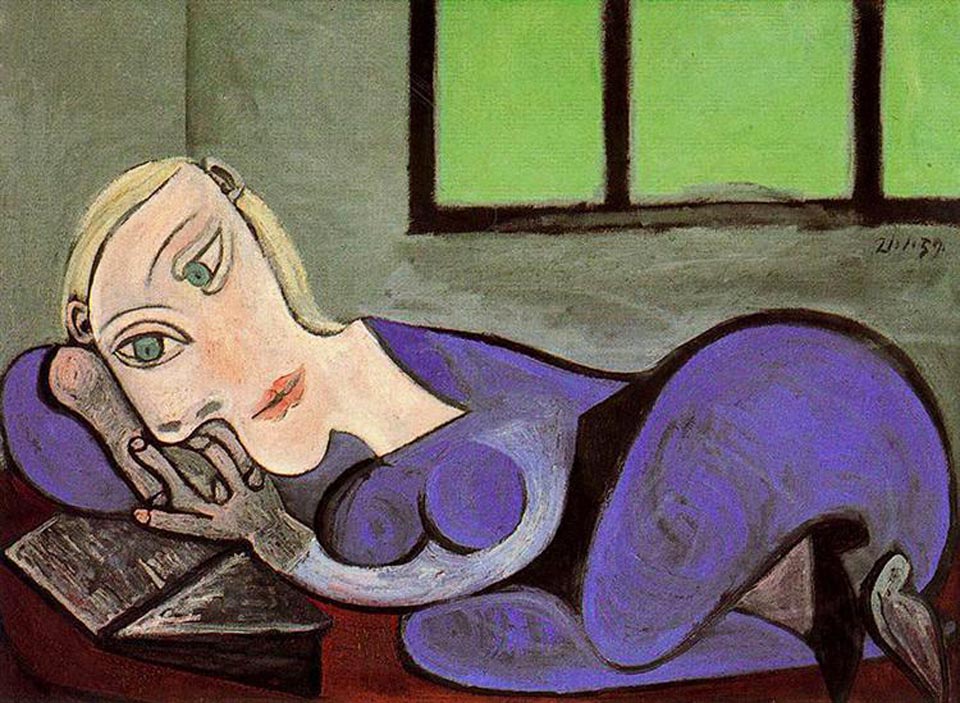 Pablo Picasso, Reclining Woman Reading, 1960, Musée Picasso, Paris, France |
|
|
|
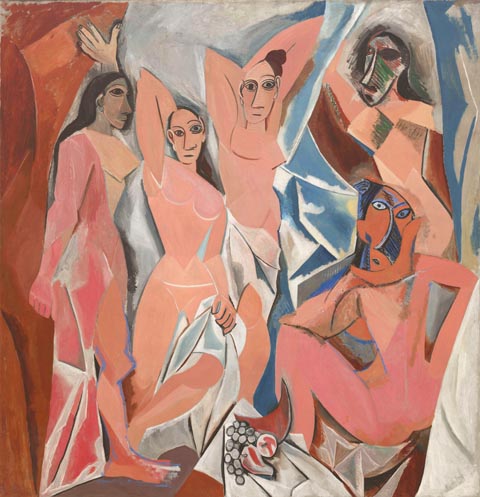 Pablo Picasso, Les Demoiselles d’Avignon, 1907. Museum of Modern Art, New York |
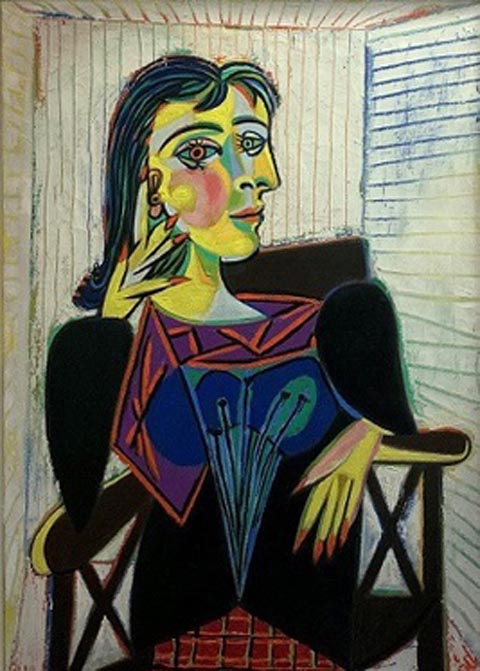 Pablo Picasso, Portrait of Dora Maar, 1937 Musee Picasso, Paris |
Picasso’s Les Demoiselles d’Avignon is basically the “boom, here comes Cubism” moment. Here are five nude women in a brothel, smashed together, fractured with jagged shapes and flat planes. Classical perspective and ideal beauty are gone. |
|
The faces are all kinds of wild with some looking Iberian and others African mask‑y or Egyptian. The debut of this painting threw the art world into a spin, with critics calling it immoral, Matisse calling it a joke, and Braque eventually using it as a springboard into Cubism. |
|
We all are familiar with the achievements of William S. Paley. He was the founder of CBS and a long-serving trustee, president, and chairman of the Museum of Modern Art, New York. His personal passion for modern art led him to amass and eventually donate an extraordinary collection of masterpieces—by artists like Cézanne, Gauguin, Matisse, Picasso, Degas, and Bacon—that significantly enriched the museum’s holdings. |
||
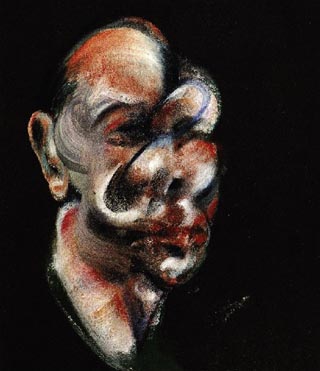 |
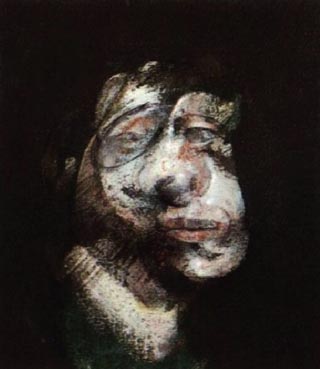 |
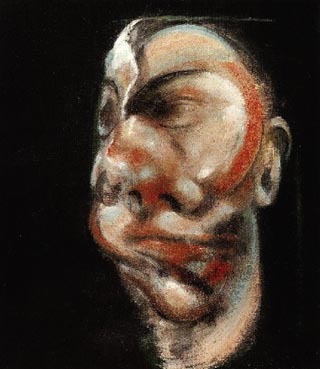 |
| Francis Bacon 1909-1992, Study for Three Heads 1962, William S. Paley Collection, Mondern Museum of Art, New York | ||
|
||
|
|
Gauguin's Seed of the Areoi stands as a hallmark of Gauguin's legacy in modernism. This Tahitian woman, believed to be Gauguin's young companion, is seated with a flowering mango in her hand, a symbolizing the mystical fertility of the vanished Areoi Society. Gauguin borrows elements from ancient Egyptian hieratic poses, while using Japanese color planes and arm positioning woven with western symbolism. Gauguin created this painting in 1892 during his first Tahitian adventure. |
|
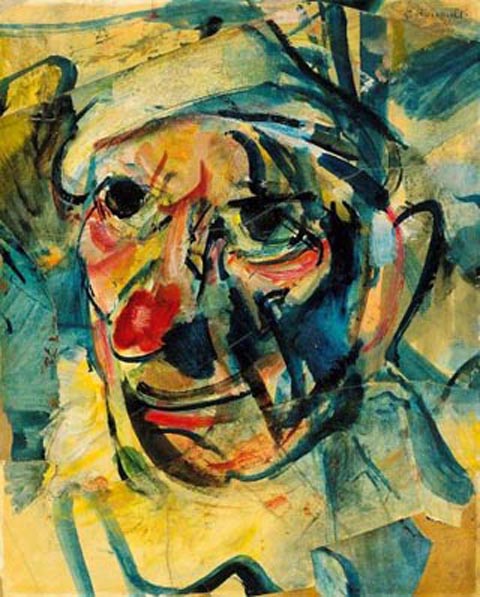 Georges Rouault, The Clown 1907 |
|
from our Mar '14 edition Modern Nature: Georgia O'Keeffe & Lake George |
Modern Nature: Georgia O'Keeffe and Lake George |
Modern Nature: Georgia O'Keeffe and Lake George was basically a deep dive into the artist’s early years, long before she relocated to New Mexico. This earlier period was back in the day when Georgia O’Keeffe spent her summers in upstate New York (Lake George) and suddenly transformed regular things like leaves, apples, barns, and the lake itself into bold, almost abstract paintings. Over a really productive decade, she whipped up more than 200 works, and the de Young pulled together about 55 of the coolest ones, close-up flowers, tree studies, still lifes, and landscapes that all show how she took simple stuff and made it modern and powerful. Below are a few of my favorite paintings. |
|
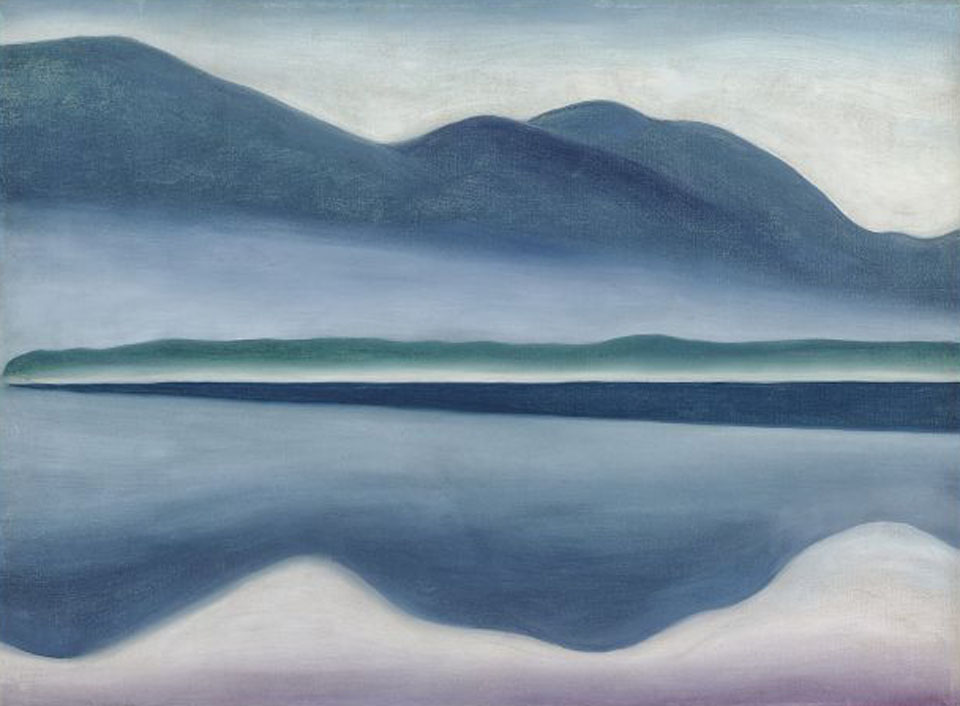 Georgia O'Keeffe, Lake George, 1922, San Francisco Museum of Modern Art |
|
Lake George 1922 captures the tranquil beauty of the Adirondack Mountains with a sense of abstraction and emotional depth. This piece exemplifies O’Keeffe’s ability to transcend mere representation, transforming a natural scene into a meditative exploration of form and color. |
|
|
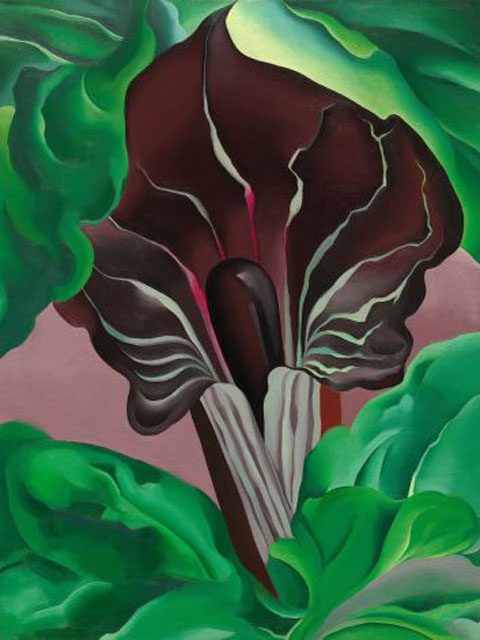 Georgia O'Keeffe, Jack in the Pulpit No 2, 1930 National Gallery of Art, Washington, DC |
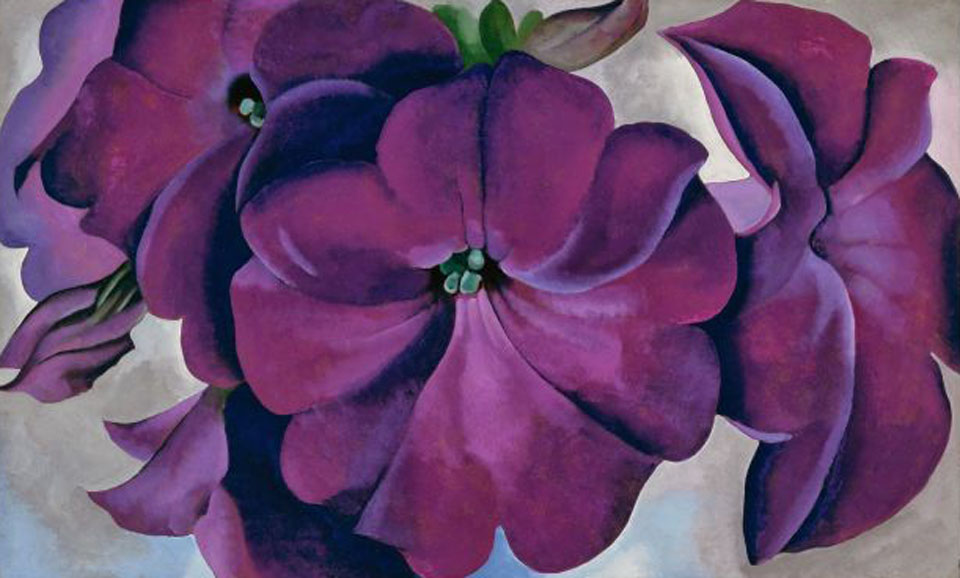 Georgia O'Keeffe, Petunias, 1925, San Francisco Modern Museum of Art, San Francisco, CA |
|
In Petunias, O’Keeffe takes something as simple as a common garden flower and turns it epic—cropping it tight, blowing its color way up, and ditching any background distractions so you’re staring right into the bloom like under a magnifying glass. Rich purples jump off a soft backdrop, making the flower feel both intimate and monumental. She once explained that she painted flowers larger than life so busy New Yorkers would be forced to really look. Mission accomplished! |
|
from our July '15 edition J. M. W. Turner: Painting Set Free at SF's de Young |
J.M.W. Turner: Painting Set Free |
J.M.W. Turner: Painting Set Free was a dazzling exhibition devoted to the artist’s late career from 1835 to 1850, when he pushed painting to its atmospheric limits. Organized by Tate Britain with the Getty and others, the show gathered more than 60 works, stormy seascapes like Snow Storm, Steam-Boat off a Harbour’s Mouth, fiery scenes such as The Burning of the Houses of Lords and Commons, and poetic visions of Rome, rarely seen together. Darkened galleries and careful lighting made his swirling color and light all the more immersive, reminding visitors why Turner’s bold experiments with mood and abstraction paved the way for Impressionism and even modern painting. |
|
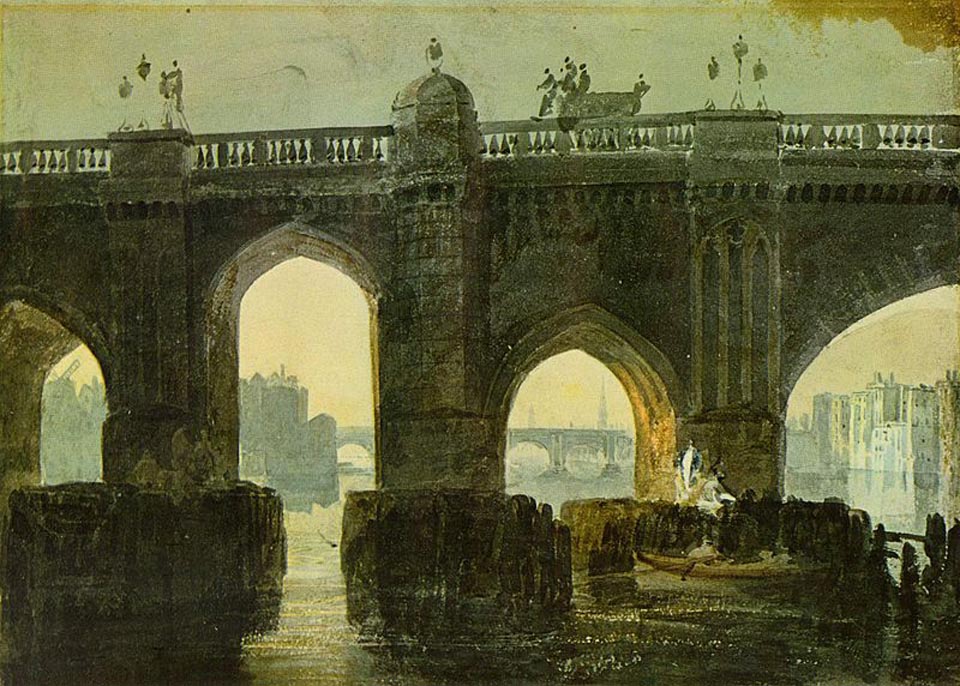 J. M. W. Turner, London Bridge 1796, Tate Britain, London, UK |
London Bridge is an earky painting by Turner when he was barely in his twenties. It shows the old London Bridge bridge crowded with life, boats jostling on the Thames, and smoke and haze softening the city beyond. You can see him balancing careful detail with a growing fascination for light and atmosphere. The river gleams, and the sky feels alive, all hinting at the bold, expressive style that would later make him famous. Even at this early date, Turner isn’t just documenting a landmark; he’s turning it into a stage for London’s energy and mood. |
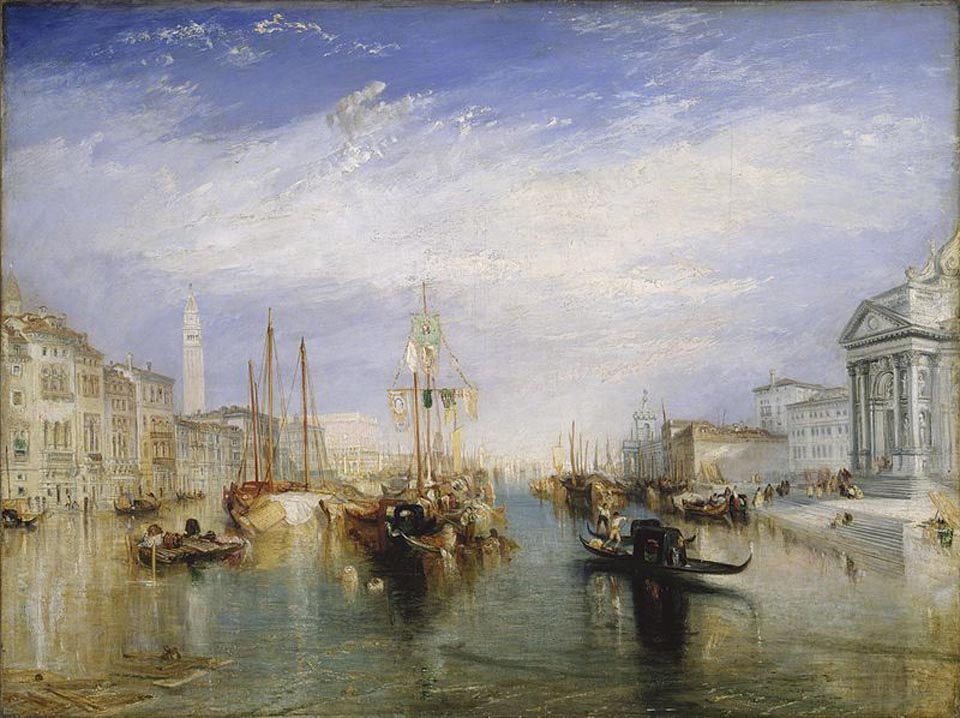 J. M. W. Turner, The Grand Canal, Venice, 1835, Huntington Library Art Museum, San Marino, California |
Painted nearly forty years after his London Bridge, Turner’s The Grand Canal, Venice done in 1835 shows how he turned a familiar landmark into pure poetry. Instead of focusing on sharp architectural detail, he bathed the canal and palaces in glowing light and soft color, so that stone, water, and sky seem to blur together. The scene feels both real and dreamlike, Venice as Turner experienced it, shimmering and atmospheric. It’s a perfect example of his late style, where mood and light mattered more than accuracy, and why later artists like the Impressionists saw him as a trailblazer. |
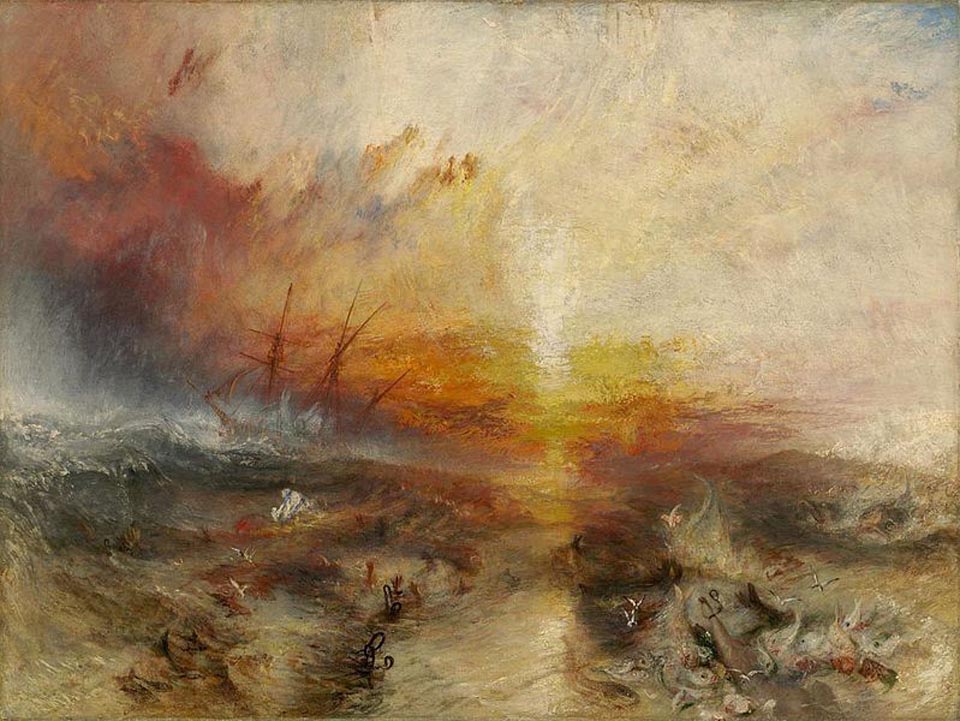 J.M.W. Turner, The Slave Ship, 1840, Museum of Fine Arts, Boston |
Turner’s The Slave Ship 1840, also called Slavers Throwing Overboard the Dead and Dying, Typhoon Coming On, is one of Turner's most powerful and unsettling works, a bold expression of his abhorrence of slavery. It’s a dazzling explosion of color, with a fiery sunset colliding with a stormy sea—visually stunning, yet deeply disturbing. A closer look reveals the evil within: chained, frantic people thrashing in the waves. This scene represents the historic Zong massacre of 1781, when a ship’s captain threw enslaved people overboard to collect insurance money. Here, the power and beauty of nature collides with a shameful human horror. Turner uses his mastery of light and atmosphere to confront viewers with the brutality of slavery and the fragility of human life. (For historical perspective, this painting was created in the same year Claude Monet was born.) |
from our January 2016 edition The de Young's Jewel City, Art from SF's Panama Pacific Exposition, 1915 |
Jewel City, Art from San Francisco's |
This exhibition reunited nearly 200 of the most memorable artworks from San Francisco’s massive 1915 world’s fair, the Panama–Pacific International Exposition. The exhibition blended world famous artists such as Monet, Sargent, Homer, and Cassatt with bold modernist shockers like Italian Futurism, Hungarian modernism, and Austrian Expressionism, all stuffed into galleries themed by region and style. And the California artists were represented too. De Young Curator James Ganz spent years tracking down works from as far away as Russia and Budapest. It was basically a one-time chance to relive the art extravaganza that helped stamp San Francisco as a cultural powerhouse. |
|
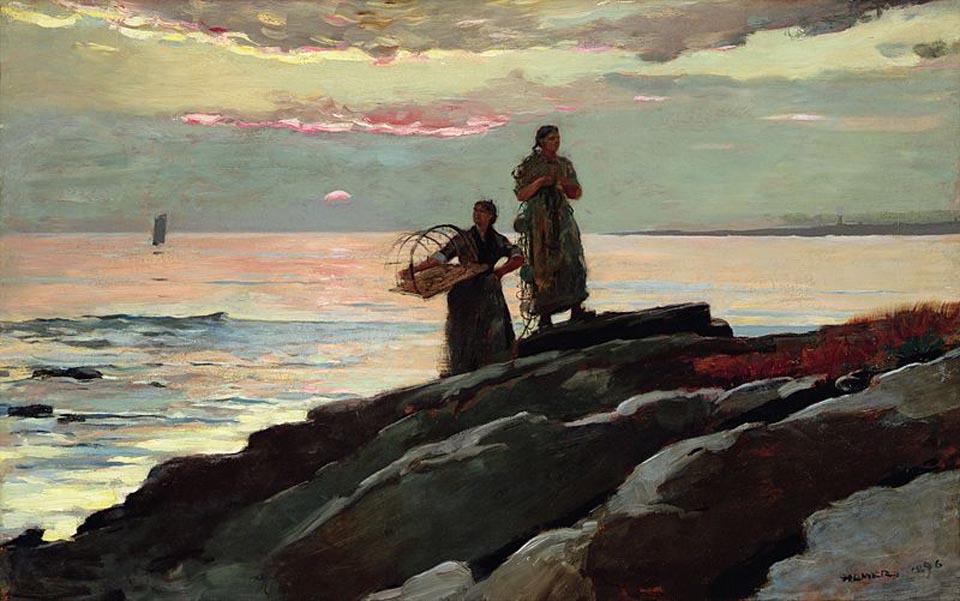 Winslow Homer 1836-1910, Saco Bay 1896, Sterling and Francine Clark Art Institute in Williamstown, Massachusetts. |
|
Winslow Homer's Saco Bay captures a silhouetted moment charged with quiet tension and natural beauty. A local woman pauses mid-step, her gaze drawn toward something just beyond the canvas’s edge, suggested by the upward lift of a gull. |
|
The exact time of day or weather is deliberately unclear, inviting multiple interpretations and engaging the viewer in the scene’s unfolding narrative. Homer painted this in 1896 near his studio in Prout's Neck, Maine |
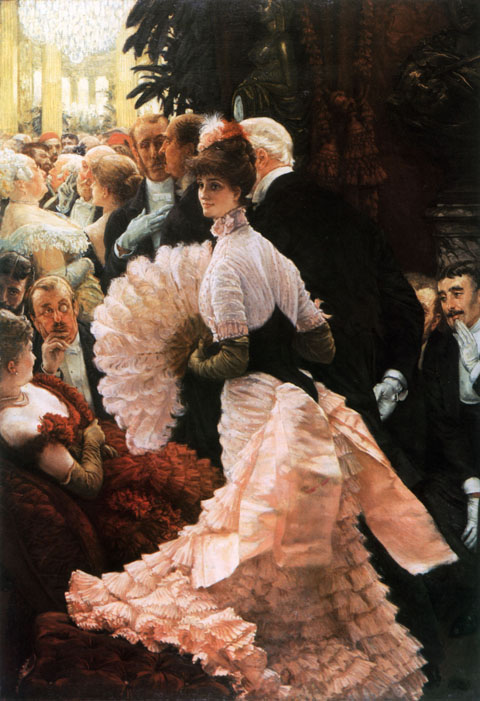 James Tissot (1836-1902), L'ambitieuse (The Political Woman) 1883-85 Albright-Knox Art Gallery, Buffalo, NY |
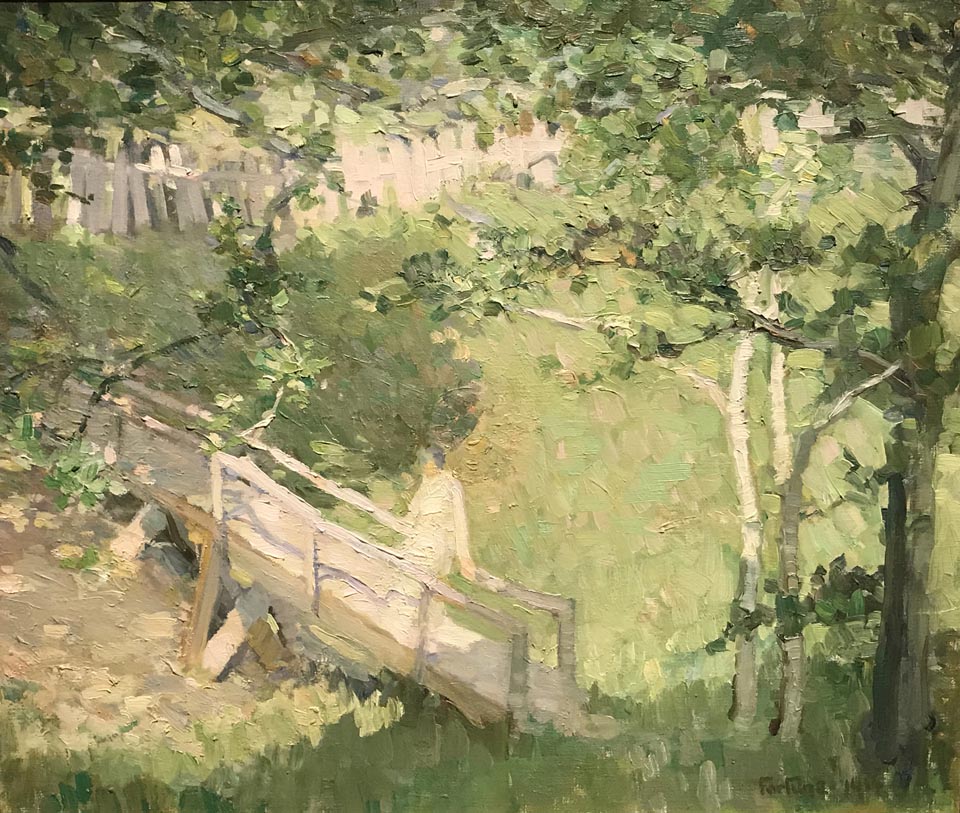 E. Charlton Fortune (1885-1969), Summer, 1914, Private Collection |
|
California painter E. Charlton Fortune’s Summer 1914 is a soft, glowing early landscape that really shows off her feel for light and mood, earning her a silver medal when it was shown at the 1915 Panama-Pacific International Exposition. Painted in calm greens with dappled sunlight, the scene feels both peaceful and alive, with a white fence and walkway that naturally lead the eye to a lone figure catching the light. You can see the influence of her teacher Arthur Mathews in the painting’s harmony and restrained palette. Critics even called it a “poem in greens,” and as much as it captures her gentle, impressionistic beginnings, it also hints at the bolder, more colorful Monterey landscapes she would become known for later in her career. |
|
from our January 2016 edition At SF's de Young, "Botticelli to Braque" Masterpieces from the National Galleries of Scotland |
Botticelli to Braque: Masterpieces from the National Galleries of Scotland |
Botticelli to Braque: Masterpieces from the National Galleries of Scotland was a blockbuster exhibition that brought more than 55 works spanning 400 years of European art across the Atlantic. Visitors got to see everything from early Renaissance gems by Botticelli and Titian to dramatic Baroque canvases by Velázquez and Rembrandt, all the way through to the bold experiments of Cézanne, Van Gogh, and Braque. It was a rare chance to trace the sweep of European painting in one show, and especially exciting since many of these works had never traveled to the U.S. before, offering Bay Area audiences a kind of whirlwind tour through art history without ever leaving Golden Gate Park. |
|
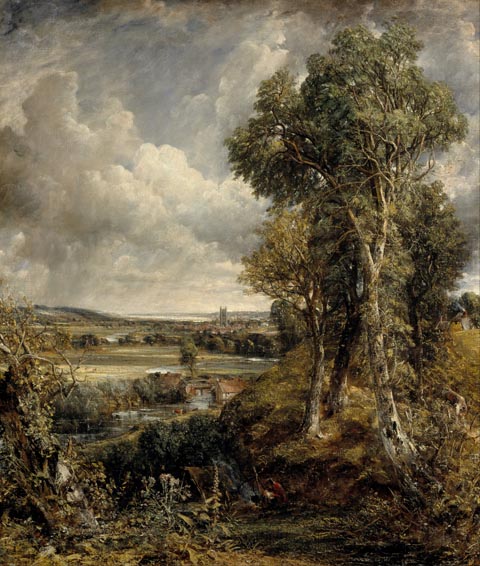 The Vale of Deadham, 1827, John Constable, 1776-1837 National Gallery of Scotland |
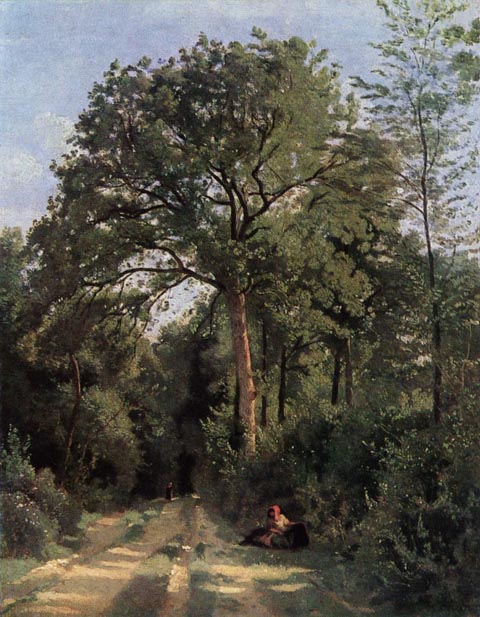 Entree du bois a Ville-d'Avray, 1825 Jean-Baptiste Camille Corot, 1796-1875, National Gallery of Scotland |
|
|
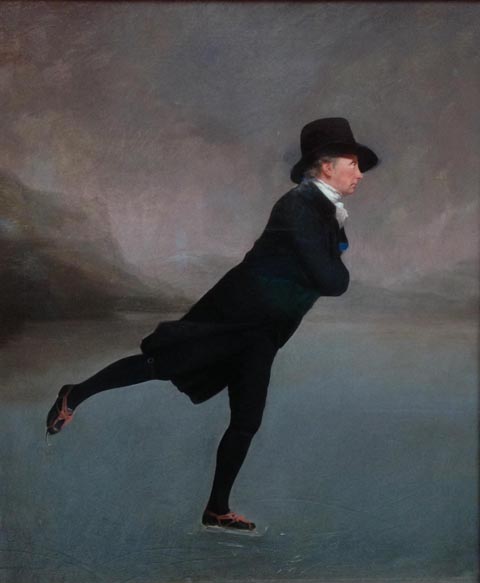 Reverend Robert Walker Skating on Duddingston Loch, 1795 Sir Henry Raeburn, 1756-1823, National Gallery of Scotland |
 Portrait of Lady Agnew of Lochnaw, 1892 John Singer Sargent, 1856-1925, National Gallery of Scotland |
One of Scotland’s most beloved paintings, Rev. Walker Skating on Duddingston shows Reverend Walker, known to friends as “Scott Skating Minister." gliding effortlessly across the frozen Duddingston Loch near Edinburgh. Raeburn captures him with a wonderful mix of elegance and humor: dressed all in black, hands folded behind his back, perfectly balanced on the ice. The composition is strikingly modern, with its strong diagonal and wide sweep of frozen landscape, yet it also feels playful and personal, as if we’ve caught the minister in a private moment of joy. Both a portrait and a slice of Scottish life, it has become an icon of national identity. |
|
from our May 2019 edition Claude Monet: The Late Years at SF's de Young Museum |
Claude Monet: The Late Years |
Monet: The Late Years included nearly 60 paintings from the artist’s final decades from 1913 to 1926. These works, almost all painted in his beloved garden at Giverny, showed Monet pushing past Impressionism into bold, sometimes nearly abstract territory with sweeping canvases of water lilies, wisteria, and willows. Some were painted during World War I, with the sound of big guns echoing through Giverny. Monet's eyesight was a huge challenge, with his canvases revealing both his resilience and reinvention, his brushwork turning looser, colors brighter, and scale more ambitious, with mural-sized studies for his famed Grandes Décorations. The show reintroduced Monet not just as the master of light and atmosphere but also as a pioneer edging toward modern abstraction. |
|
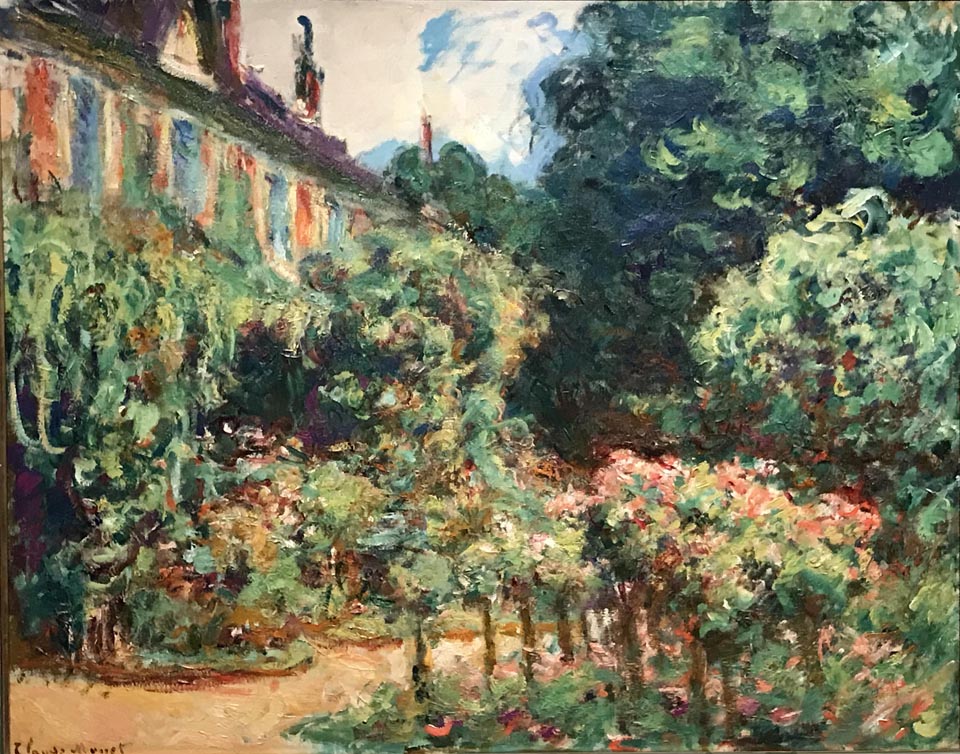 Claude Monet, The Artist's House at Giverny, 1912-13, Private Collection |
|
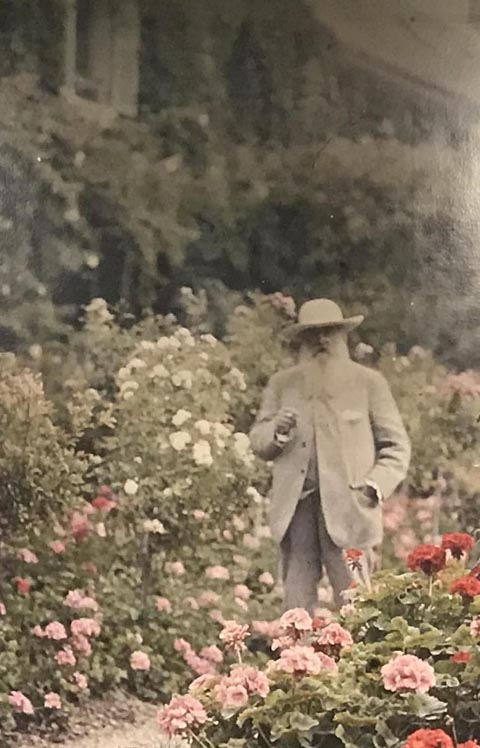 Claude Monet in his garden at Giverny, This wall sized mural photo welcomed visitors to Monet: The Late Years |
|
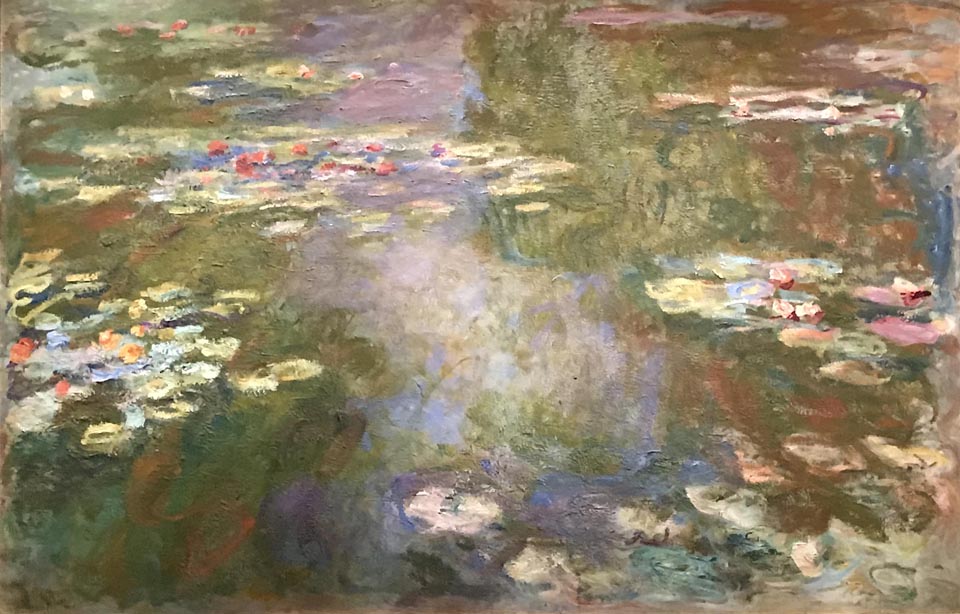 Claude Monet, Water-Lily Pond, 1917-19 Art Institute of Chicago |
|
This painting radiates vitality and beauty. Monet paints his beloved Giverny pond into a boundless, almost spiritual meditation on light and nature. |
|
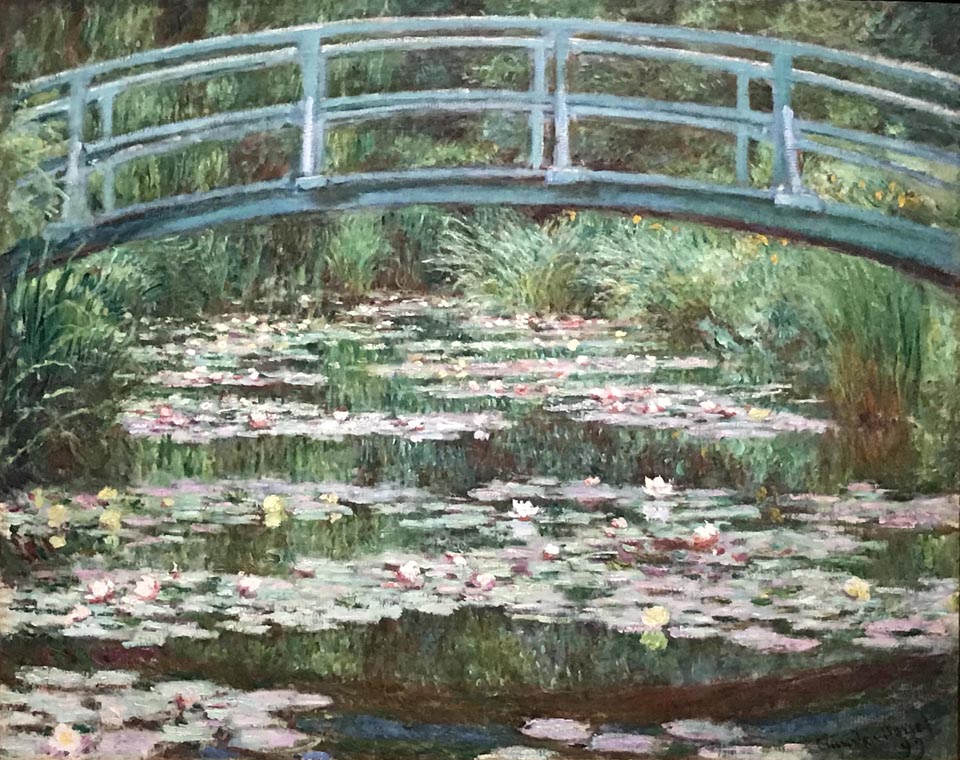 Claude Monet, The Japanese Footbridge, 1899 National Gallery of Art, Washington, D.C., |
|
The Japanese Footbridge 1899 captures Monet's garden at Giverny—the graceful arched bridge spanning his lily pond. Painted with shimmering, quick strokes of green, blue, and violet, the work shows how Monet transformed a simple garden feature into a stage for studying light, reflection, and atmosphere. The bridge anchors the composition, but it’s the surrounding rippling water and lush foliage that steal the show, dissolving into a haze of color that feels almost dreamlike. This painting is both a portrait of Monet’s carefully cultivated sanctuary and a statement of his belief that nature, when filtered through light and season, could become pure poetry on canvas. |
|
from our Nov 2024 edition Tamara de Lempicka at SF's de Young |
Tamara de Lempicka |
The de Young staged the first major U.S. retrospective of Art Deco icon Tamara de Lempicka featuring over 100 works. She is best known as the ultimate Art Deco painter, celebrated for her large, slick, polished portraits of glamorous aristocrats and the wealthy, plus her highly stylized, sensual nudes that capture the sleek spirit of the Jazz Age. Prior to this exhibition, I had not heard of her, but from now on, I'm a fan of Tamara de Lempicka and the Art Deco movement, an expressiveness and eloquence marking a stunning and unique period in American art. |
|
 Tamara de Lempicka, Young Woman in Green (Young Woman with Gloves) c 1931 oil on board, Centre Pompidou, Musée national d'art moderne, Centre de création industrielle, Paris |
 Tamara de Lempicka, Saint-Moritz 1929 oil on panel, Musée des Beaux-Arts d'Orléans, France |
Young Woman in Green presents a sleek, futuristic portrait of a confident modern woman: draped in a vibrant, fluttering green dress that clings like a second skin. She shades her eyes from beneath a wide-brimmed hat as she gazes forward into the future. Rendered as if sculpted by machines—with smooth geometric forms, conical breasts, and a defined navel—she embodies the optimism, sensuality, and liberation of the interwar "modern woman." |
|
 Tamara de Lempicka, Escape (Somewhere in Europe) 1940 oil on canvas, Musée d'arts de Nantes, France |
 Tamara de Lempicka, Wisdom (La sagesse) 1940-41 oil on panel, Colección Pérez Simón, Mexico |
|
|
The special exhibition rooms of the de Young are nothing really special! Over the years, the vast quantity and quality of world class art I've seen there is absolutely staggering! The paintings shown throughout this article are but a small sampling of what was exhibited. We all owe the de Young, the Legion of Honor, and the Crocker Museum a salute and our gratitude. They have brought great treasures to our region. A generous salute of gratitude to all the curators who brought these exhibitions to life. And, there's a good one coming up ... see the gallery news below for news of Manet and Morisot coming to the Legion of Honor starting October 11. I will be reporting on this show in our November newsletter. |
|
| Gallery News |
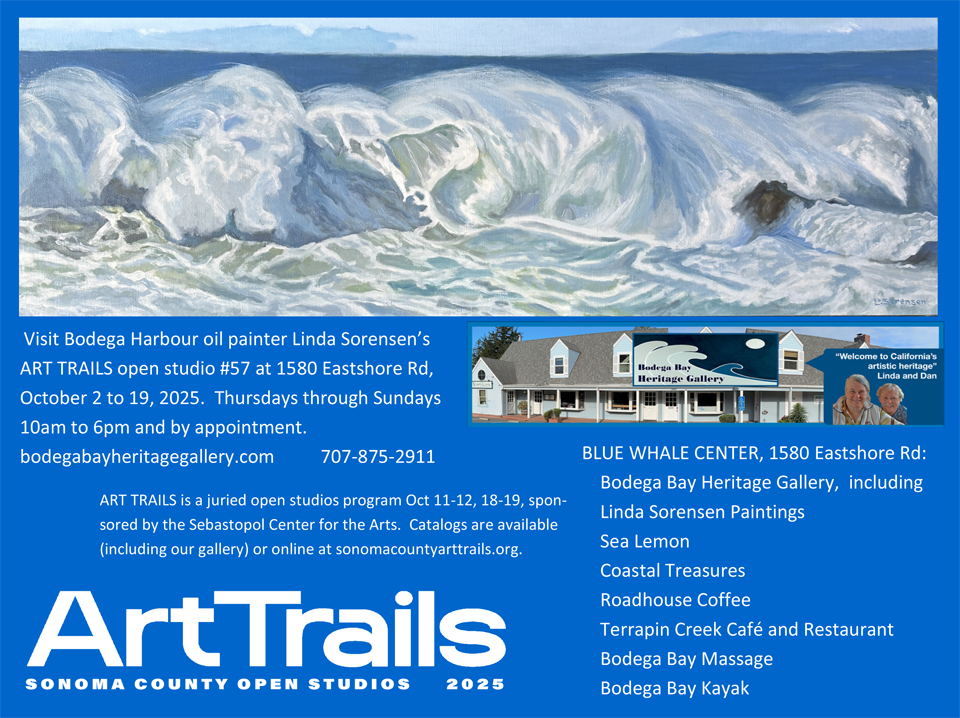 |
Our gallery has a fresh new look. Linda Sorensen's ART TRAILS Open Studio is in the front room, while the back room presents a sampling of our gallery's best historic artists from California's past. |
 Édouard Manet The Balcony 1868 Musée d'Orsay, Paris |
Coming Soon to the Legion of Honor (will be featured in our Nov. Newsletter) Manet and Morisot Oct 11, 2025 - March 1, 2026 |
 Édouard Manet Berthe Morisot with Bouquet of Violets 1872, Musée d'Orsay, Paris |
This is one not to miss! |
 Gustave Caillebotte 1848-1894, The Floor Scrapers (Les raboteurs de parquet) 1875 Musée d'Orsay, Paris |
|
From our June Newsletter Gustave Caillebotte: Impressionist Painter and Patron |
| ... in and around Bodega Bay | ||
 |
Bodega Bay Heritage Gallery 1580 Eastshore Road Between the Terrapin Creek Cafe and Roadhouse Coffee open Thurs-Sun, Noon 'till 5 -- other times by chance or appointment an exceptional collection of late 19th and early 20th century paintings by well known California artists http://www.BodegaBayHeritageGallery.com | Call or Text 707-875-2911 email: Art@BodegaBayHeritageGallery.com |
 "Mendocino Coast" Joshua Meador |
 Ren Brown |
The Ren Brown Collection Just steps away from Bodega Bay Heritage Gallery A sumptuous gallery experience ... Contemporary Japanese Prints, Handmade Ceramics & Jewelry, Japanese Antiques, California Artists & Sculptors 1781 Coast Highway One, Bodega Bay, 94923 |
 |
Linda Sorensen Paintings Linda paints colorful and imaginative / transcendental-influenced |
 |
|
 |
In the nearby town of Bodega ... Dodrill Gallery 17175 Bodega Highway, Bodega CA 94922 Famed photographer, world adventurer and rock climber Jerry Dodrill exhibits and sells and his exceptional landscape photographs ... https://jerrydodrill.photoshelter.com/p/page2 | 707-377-4732 Photo@JerryDodrill.com| Back to the Top |
 |
 |
In the nearby town of Bodega ... Artisans' Co-op featuring the talents of local artists ... photography, paintings, textiles, jewelry, ceramic and wood art 17175 Bodega Highway, Bodega CA 94922 ... http://www.artisansco-op.com| 707-876-9830 Back to the Top |
|
 |
Bodega Gallery in the historic town of Bodega (This gallery has closed, with a for sale sign posted) |
 |
 |
Bodega Bay's John Hershey Photography Bodega Bay resident photographer John Hershey displays his scenic shoreline and sea life images locally in restaurants, visitor venues and art shows. His 50 year career has encompassed multimedia production, commercial and personal photography, environmental portraiture, and community photojournalism. John recently added interpretive infrared photography to his portfolio. John Hershey Photography Portfolio ... http://www.jhersheyphoto.com John Hershey Photography Sales ... https://j-hershey-media.square.site |
 |
\ |
Bodega Bay's Jean Warren Watercolors Bodega Bay resident Jean Warren says her paintings are reflections of the places she has lived and traveled. Jean is a Signature member of the National Watercolor Society, California Watercolor Association and full member of Society of Layerists in Multi-Media. http://www.JeanWarren.com / 707-875-9240 |
|
| Also in Sonoma County ... | ||
 |
IN SEBASTOPOL - Sebastopol Center for the Arts |
|
 Corrick's Keven Brown |
IN SANTA ROSA Corrick's Art Trails Gallery | http://www.corricks.com/arttrailsgallery 637 Fourth Street, Santa Rosa, CA 95401 | Contact:: http://www.corricks.com/contact-us Corrick's has been a Santa Rosa Treasure since 1915, a downtown stationery store serving as the community's "cultural hub." Corrick's has long supported local artists with its impressive "ART TRAILS GALLERY," including paintings by Linda Sorensen. Corricks offers a number of originals by famed Santa Rosa artist, Maurice Lapp ... (see our August 2017 article) located on Fourth Street, steps away from Santa Rosa's revitalized town square and Fourth Street's Russian River Brewery |
 Linda Sorensen's White Barn circa 1880, Sea Ranch currently available at |
 Dennis Calabi |
Calabi Gallery currently online only ... CalabiGallery.com email: info@calabigallery.com | 707-781-7070 Famed master conservator Dennis Calabi brings his rare knowledge and experience to present a tasteful and eclectic array of primarily 20th century artwork. http://www.calabigallery.com | Back to the Top |
 Easton, Crustacean Dancing Dream, American Alabaster |
 |
IN Santa Rosa - The Annex Galleries specializing in 19th, 20th, and 21st century American and European fine prints The Annex Galleries is a member of the International Fine Print Dealers Association (IFPDA). http://www.AnnexGalleries.com | Back to the Top |
|
 |
IN GRATON - Graton Gallery |
|
 |
IN DUNCANS MILLS - Christopher Queen Galleries 3 miles east of Hwy 1 on Hwy 116 on the Russian River http://www.christopherqueengallery.com |707-865-1318| Back to the Top Established in 1976, the gallery features Early California and Contemporary art. |
|
 |
IN Healdsburg - Paul Mahder Gallery http://www.paulmahdergallery.com (707) 473-9150 | Info@paulmahdergallery.com 222 Healdsburg Avenue, Healdsburg, CA 95448 | check for hours |
|
 |
|
 |
| Links to current museum exhibits relevant to Early California Art | |||
| The Greater Bay Area | |||
| The Walt Disney Family Museum -- see website for details This museum tells Walt's story from the early days. (on the Parade Grounds) 104 Montgomery Street, The Presidio of San Francisco, CA 94129 -- view location on Google Maps -- |
 |
San Francisco ... see website de Young Museum Permanent Collection |
 |
| San Francisco closed, see website California Historical Society |
 |
San Francisco Legion of Honor ... see website -Permanent European and Impressionist Paintings |
 |
| San Francisco open, see website for details Contemporary Jewish Museum |
 |
Oakland ... see website Oakland Museum of California -- ongoing Gallery of California Art -showcasing over 800 works from the OMCA's collection |
 |
San Francisco |
 |
Santa Rosa |
 |
| Santa Rosa ... see website Charles M. Schultz Museum |
 |
Moraga |
 |
| Sonoma Mission San Francisco de Solano Museum featuring the famed watercolor paintings of the California Missions by Christian Jorgensen |
 |
Sonoma Sonoma Valley Museum of Art ... see website 551 Broadway, Sonoma CA (707) 939-7862 |
 |
| Ukiah Grace Hudson Museum ... see website http://www.gracehudsonmuseum.org |
 |
Bolinas |
 |
| Walnut Creek ... see website The Bedford Gallery, Lesher Center for the Arts |
 |
San Jose San Jose Museum of Art ... see website approximately 2,000 20th & 21st century artworks including paintings, sculpture, new media, photography, drawings, prints, and artist books. |
 |
| Monterey Monterey Museum of Art ... see website Ongoing exhibitions ... Museums Permanent Collection including William Ritschel, Armin Hansen and E. Charlton Fortune http://www.montereyart.org |
 |
Palo Alto ... see website Cantor Art Center at Stanford University |
 |
Monterey |
 |
Sacramento Crocker Art Museum ... see websites |
 |
| Sacramento Capitol Museum ... see website Governor's Portrait Gallery Permanent Exhibits (including one of our galllery's favorite artists, Robert Rishell's portrait of Gov. Ronald Reagan |
 |
Stockton's Treasure! The Haggin Museum ... see website -Largest exhibition of Albert Bierstadt paintings anywhere, plus the works of Joseph Christian Leyendecker, Norman Rockwell's mentor. see our Newsletter article, April 2011 |
 |
| Southern California (and Arizona) (for all museums below, see websites for hours and protocols. | |||
| Los Angeles Los Angeles Museum of Art Art of the Americas, Level 3: Artworks of paintings and sculptures from the colonial period to World War II— a survey of of art and culture & "Levitated Mass" |
 |
Irvine UCI IMCA (University of California, Irvine Institute and Museum of California Art) (formerly The Irvine Museum) |
 |
| Santa Barbara The Santa Barbara Museum of Art |
 |
Orange Hilbert Museum, Chapman University |
 |
| San Diego San Diego Museum of Art Permanent Collection |
 |
Pasadena Norton Simon Museum -an Impressive Permanent collection, European impressionist and post impressionist paintings See our newsletter from March 2014 |
 |
| Los Angeles California African American Art Museum adjacent to the LA Coliseum (see our newsletter articleof their Ernie Barnes Exhibition September 2019) |
 |
San Marino (near Pasadena) The Huntington Library American Art Collection Paintings by John Singer Sargent, Edward Hopper, Robert Henri, Albert Bierstadt, Thomas Moran, William Keith, Mary Cassatt, Thomas Hart Benton and many more. |
 |
| Phoenix, AZ Phoenix Art Museum an excellent sampling of Artists of the American West |
 |
Palm Springs |
 |
| & Beyond | |||
| Honolulu, HI Honolulu Museum (see our Newsletter article from February, 2015) |
 |
Kamuela, HI (Big Island) Issacs Art Center 65-1268 Kawaihae Road Kamuela, HI 96743 (See our Dec '16 article "Hawaii's Paul Gauguin," modernist Madge Tennent, 1889-1972) |
 |
| Seattle, WA Seattle Art Museum ( see our article Mar 2018 French and American Paintings ) |
 |
Portland, OR Portland Art Museum Permanent Collection: American Art |
 |
| Washington D.C. The Renwick Gallery Permanent ... Grand Salon Paintings from the Smithsonian American Art Museum |
 |
Chicago, IL Art Institute of Chicago Permanent collection: the Impressionists |
 |
| Cedar Rapids, IA The Cedar Rapids Museum of Art Grant Wood: In Focus is an ongoing permanent collection exhibition. |
 |
Bentonville, AR |
 |
| Washington D.C. The National Gallery Permanent collection American Paintings |
 |
Philadelphia , PA The Philadelphia Museum of Art |
 |
| Philadelphia , PA Barnes Foundation, Philadelphia Campus |
 |
Brooklyn, NY The Brooklyn Museum American Art Permanent Collection |
 |
| New York , NY The Whitney Museum of American Art The largest selection of works by Edward Hopper |
 |
New York, NY Metropolitan Museum of Art Its extensive collection of American Art |
 |
| Detroit, MI Detroit Institute of Arts American Art Permanent Collection |
 |
Ottawa, Ontario National Gallery of Canada |
 |
| Denver, CO Denver Art Museum |
 |
Boston, MA |
 |
| If you wish to sell a painting to us ... |
|